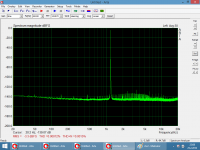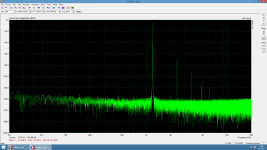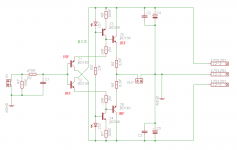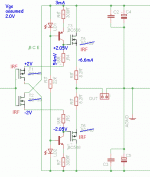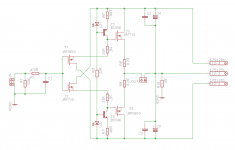Dear diyaudio members! It's nice to be here 
I've been reading this forum for years...
I have read some topics on diamond buffers with mosfets. Whether their usage is appropriate or not. But now i have specific experience.
My diamond buffer is a basic one with two current sources.
I was working with 2SA high speed transistors TOSHIBA and SANYO in TO-126 enclosement. That works very well. THD is 0,00012%. DC offset is some small mV.
But i was testing IRF mosfets 2SA9610 and IRF710. I tested also IRF610, but it didn't work very differently. Mosfets sounds very good, but measurements aren't. THD is 0,06% and DC offset was always around 270mV. I measured DC offset at 3 channels. Current on emitter resistors is very stable, i have now 16mA with mosfets.
Also mosfets are more noisy at 50-100Hz on speakers (by ear). I also measured oscilations with my 200MHz TEK, but i didn't see any problem on the display. Also i tested resistors directly at input to mosfets and directly at output, but it didn't influence the measurement in any way.
Does anybody have an idea, how can I improve these measurements? Thank you very much.

I've been reading this forum for years...
I have read some topics on diamond buffers with mosfets. Whether their usage is appropriate or not. But now i have specific experience.
My diamond buffer is a basic one with two current sources.
I was working with 2SA high speed transistors TOSHIBA and SANYO in TO-126 enclosement. That works very well. THD is 0,00012%. DC offset is some small mV.
But i was testing IRF mosfets 2SA9610 and IRF710. I tested also IRF610, but it didn't work very differently. Mosfets sounds very good, but measurements aren't. THD is 0,06% and DC offset was always around 270mV. I measured DC offset at 3 channels. Current on emitter resistors is very stable, i have now 16mA with mosfets.
Also mosfets are more noisy at 50-100Hz on speakers (by ear). I also measured oscilations with my 200MHz TEK, but i didn't see any problem on the display. Also i tested resistors directly at input to mosfets and directly at output, but it didn't influence the measurement in any way.
Does anybody have an idea, how can I improve these measurements? Thank you very much.
Attachments
Last edited:
If T5 and T6 are mosfets, then they would be totally turned off in the arrangement you show. Bipolar transistors are on at about 0.6 V Vbe. MOSFETS need something a bit above the threshold voltage, typically 2.5 to 4 volts, depending upon the MOSFET.
So...you should increase R4 and R5 until the output mosfets start to draw some quiescent current.
So...you should increase R4 and R5 until the output mosfets start to draw some quiescent current.
In a diamond buffer the driver and the output should be the same type of transistor.
The reason is level shifting. From input to emitter/source of the drive, we measure 0.65/3.8, resp for bipolar and hexfet. From input to emitter/source of the drive, we try to set up the same voltages, so that input to output avoids offsets.
But there is another reason too. The high/low voltage shifting is a potential for distortion. Ideally the drivers and the outputs should pass the same current right through the entire waveform so that input to output delivers zero offset, and therefore zero distortion. Of course this cannot happen, but drivers necessarily pass much less current than output devices. Realistically we live with the unequal base-emitter and gate-source differences, but it's much worse if we mix bipolar with mosfet. These small voltages are in fact not very linear, they are related to the transconductance of these devices and cannot be changed.
You can minimise these voltage differences if you adapt the driver current to track the output current, albeit with much lower levels than the output. You can remove idle offset with emitter/source resistors (you have 18R in your driver emitters, for example) but they are linear and do not match the non-linear Vbe/Vgs of the active devices.
The result is that a diamond buffer with no global feedback to reduce these errors to low values will always have a lot of measured distortion. If you use a push pull circuit, as most designers will, the artefacts occur at higher levels of signal, on both pos and neg half cycles. This leads to odd orders, third, fifth, seventh harmonics and beyond.
Even so, a simple diamond buffer sounds very good, so if you measure high levels of THD, dominated by odd orders, the sound quality is surprisingly good.
You can use your circuit with a mosfet if you use a bipolar master/mosfet slave CFP at the output stage. In this situation the dominant transfer is created by a constant current bipolar, matching your driver constant current. That might be your best option.
Cheers,
Hugh
The reason is level shifting. From input to emitter/source of the drive, we measure 0.65/3.8, resp for bipolar and hexfet. From input to emitter/source of the drive, we try to set up the same voltages, so that input to output avoids offsets.
But there is another reason too. The high/low voltage shifting is a potential for distortion. Ideally the drivers and the outputs should pass the same current right through the entire waveform so that input to output delivers zero offset, and therefore zero distortion. Of course this cannot happen, but drivers necessarily pass much less current than output devices. Realistically we live with the unequal base-emitter and gate-source differences, but it's much worse if we mix bipolar with mosfet. These small voltages are in fact not very linear, they are related to the transconductance of these devices and cannot be changed.
You can minimise these voltage differences if you adapt the driver current to track the output current, albeit with much lower levels than the output. You can remove idle offset with emitter/source resistors (you have 18R in your driver emitters, for example) but they are linear and do not match the non-linear Vbe/Vgs of the active devices.
The result is that a diamond buffer with no global feedback to reduce these errors to low values will always have a lot of measured distortion. If you use a push pull circuit, as most designers will, the artefacts occur at higher levels of signal, on both pos and neg half cycles. This leads to odd orders, third, fifth, seventh harmonics and beyond.
Even so, a simple diamond buffer sounds very good, so if you measure high levels of THD, dominated by odd orders, the sound quality is surprisingly good.
You can use your circuit with a mosfet if you use a bipolar master/mosfet slave CFP at the output stage. In this situation the dominant transfer is created by a constant current bipolar, matching your driver constant current. That might be your best option.
Cheers,
Hugh
Last edited:
Gentlebeings: mechanik's build has four MOSFETs but his drawing shows BJTs. Let's look at it that way. I think I got it right in the attached.
However he needs both P and N types, and I do not see what is used for the P-type?
The bias works-out. All MOSFETs run at several mA. This may not be enough to wake-up a *big* IRF, but it will conduct some.
0.06% is not bad. This is a fancy "cathode follower". Distortion is reduced by how much gain we sacrifice; in this case to unity gain.
A naked BJT will have about 25% THD at large signal, and at 3mA the hie is about 10 Ohms, so in 10K load we have 1000:1 THD reduction, 0.025% at high level and less at low level. The Diamond cancels a large part of this. With BJT, THD numbers with many zeros are possible.
The MOSFET's "hie" is not calculable from theory. IRF710 is 1S at 1.2 Amps, but we are nearer 5mA. MOSFET Gm varies along several different laws. I can believe either 0.06S or 0.004S. Say 0.01S, or "hie" of 100 Ohms. Into 10K load we have 100:1 THD reduction. Assuming the more-linear MOSFET has 5% THD at high level, we may have 0.05% at low level. I would expect the Diamond to reduce this, but in MOSFETs the N-type and P-type are even more different than BJTs.
The gate-source voltage is large and typically much more variable. Do note that many MOSFETs are "ion implanted" to set their Vgs(th) to say 2V-4V range, so they may not be totally wild. But the Vgs is not an intrinsic natural law, like BJTs, and is not critical in most MOSFET applications, so is bound to be more variable.
Yes, MOSFETs have large 1/f noise. A.S. Grove touches on this in his book (ISBN 0-471-32998-3); there's lots of academic studies. The short answer is don't use large MOSFETs for input devices at line level.
However he needs both P and N types, and I do not see what is used for the P-type?
The bias works-out. All MOSFETs run at several mA. This may not be enough to wake-up a *big* IRF, but it will conduct some.
0.06% is not bad. This is a fancy "cathode follower". Distortion is reduced by how much gain we sacrifice; in this case to unity gain.
A naked BJT will have about 25% THD at large signal, and at 3mA the hie is about 10 Ohms, so in 10K load we have 1000:1 THD reduction, 0.025% at high level and less at low level. The Diamond cancels a large part of this. With BJT, THD numbers with many zeros are possible.
The MOSFET's "hie" is not calculable from theory. IRF710 is 1S at 1.2 Amps, but we are nearer 5mA. MOSFET Gm varies along several different laws. I can believe either 0.06S or 0.004S. Say 0.01S, or "hie" of 100 Ohms. Into 10K load we have 100:1 THD reduction. Assuming the more-linear MOSFET has 5% THD at high level, we may have 0.05% at low level. I would expect the Diamond to reduce this, but in MOSFETs the N-type and P-type are even more different than BJTs.
The gate-source voltage is large and typically much more variable. Do note that many MOSFETs are "ion implanted" to set their Vgs(th) to say 2V-4V range, so they may not be totally wild. But the Vgs is not an intrinsic natural law, like BJTs, and is not critical in most MOSFET applications, so is bound to be more variable.
Yes, MOSFETs have large 1/f noise. A.S. Grove touches on this in his book (ISBN 0-471-32998-3); there's lots of academic studies. The short answer is don't use large MOSFETs for input devices at line level.
Attachments
Last edited:
This is first position where i'm working with mosfet... Sorry for my schematic with bipolar transistors. Now I send real schematic. On R8 or R9 i have really around 16mA. Also now R4 and R5 (18R) i have replaced to 220R, but it is not working different. Yes, i was modified the current in current sources... And sorry for my english. Thanks.
Attachments
- Status
- This old topic is closed. If you want to reopen this topic, contact a moderator using the "Report Post" button.
